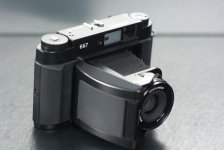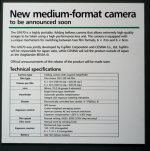You are using an out of date browser. It may not display this or other websites correctly.
You should upgrade or use an alternative browser.
You should upgrade or use an alternative browser.
Fuji GF670 demo model on Photokina
- Thread starter Ernst Dinkla
- Start date
- Latest activity Latest activity:
- Replies 103
- Views 20K
ClaremontPhoto
Jon Claremont
The depth does look rather large to me.
Maybe there are reasons for that; although I seem to recall 6x6 folders from 50 years or so ago which folded flat.
Maybe there are reasons for that; although I seem to recall 6x6 folders from 50 years or so ago which folded flat.
whitecat
Lone Range(find)er
Is this plastic or metal construction?
Roger Hicks
Veteran
Felt like metal.
Cheers,
R.
Cheers,
R.
Ernst Dinkla
Well-known
A bit more info:
Roger,
Did you see a significant change in actual frame width between the two settings ?
Based on the viewfinder window in some pictures I estimated the frame size at 56x78 mm which is 22 mm wider than the 56x56 square format. If they add that two format choice it should have some difference. However parallax compensation could be a reason for a wider viewfinder window and normally 56x78mm will be called 6x8. The width of the body will not limit the frame size in this case.
Ernst Dinkla
PMCC
Late adopter.
Roger,
What was your initial sense of it in the hand, in terms of size, weight and form factor, relative to classic folders you have known? Perhaps, for example, compared to a Zeiss Super Ikonta B?
pmcc.
What was your initial sense of it in the hand, in terms of size, weight and form factor, relative to classic folders you have known? Perhaps, for example, compared to a Zeiss Super Ikonta B?
pmcc.
KoNickon
Nick Merritt
Gee, if it's actually brass, wouldn't that be great? Or some sort of real metal. I'm not wild about the plastic-fantastic composition of the Bessa Rs.
chippy
foo was here
There are more details in the hand copied text somewhere in the middle of this thread. That text has gone on a worldwide tour on blogs it seems.
To add a bit more detail, I tried to estimate the outer dimensions. Not only for the price you will need deep pockets, it will be approximately 170 mm wide, 105 mm high and 58 mm deep when folded. The lugs and eye cup not measured. None of my 6x6 and 6x9 folders are as deep and wide as this 6x7 is. It is as high as the Iskra which is necessary with a viewfinder window that big. I wonder how deep the Bessa II is of which it borrowed the arched folder lid, less in my estimation.
Ernst Dinkla
Ernst,
the bessa II (6x9) is 165mm wide, 100mm high with accessory shoe (95mm without one as the first model Bessa II is) and 47-48mm depth, and weighs 862g without a battery 😉
Last edited:
Ernst Dinkla
Well-known
Bessa III on German Voigtländer website
Bessa III on German Voigtländer website
http://www.voigtlaender.de/cms/voigtlaender/voigtlaender_cms.nsf/id/pa_fdih7jzjul.html
Spring 2009 available in Germany
A good frontal picture but no extra information than we have already.
Ernst Dinkla
Bessa III on German Voigtländer website
http://www.voigtlaender.de/cms/voigtlaender/voigtlaender_cms.nsf/id/pa_fdih7jzjul.html
Spring 2009 available in Germany
A good frontal picture but no extra information than we have already.
Ernst Dinkla
Solinar
Analog Preferred
It looks like the German market is set to receive the Bessa III next year, which is good news.
Cyrus
Dr
In Europe we will see it as Bessa III
In Europe we will see it as Bessa III
http://www.voigtlaender.de/cms/voigtlaender/voigtlaender_cms.nsf/id/pa_home_e.html
In Europe we will see it as Bessa III
http://www.voigtlaender.de/cms/voigtlaender/voigtlaender_cms.nsf/id/pa_home_e.html
Roger Hicks
Veteran
On the one I tried -- a prototype Bessa III rescued from under glass -- yes, the frame width was significantly different; I'd guess 56x56 + 56x68 to 70, but I didn't measure it (sorry!). It might easily have been the Linhof 56x72mm size.
The 'bulgy' front and thumb-grip shaping on the back makes it look and feel quite a bit bigger than some traditional folders, but realistically this is only a matter of a few millimetres. It's more comfortable to hold than an old 'boxy' square-edge folder, without quite the feeling of solidity and cold metal -- which is what you'd expect, 50-80 years on with the advantage of new covering materials. The bellows are NOT self-erecting -- it's pull and click -- and this should aid both durability and rigidity: it seemed well rigid to me.
The thing is, I'm not a great folder addict, and I had to go over a lot of show, so I spent only a few minutes with it (again, sorry!).
Cheers,
R.
The 'bulgy' front and thumb-grip shaping on the back makes it look and feel quite a bit bigger than some traditional folders, but realistically this is only a matter of a few millimetres. It's more comfortable to hold than an old 'boxy' square-edge folder, without quite the feeling of solidity and cold metal -- which is what you'd expect, 50-80 years on with the advantage of new covering materials. The bellows are NOT self-erecting -- it's pull and click -- and this should aid both durability and rigidity: it seemed well rigid to me.
The thing is, I'm not a great folder addict, and I had to go over a lot of show, so I spent only a few minutes with it (again, sorry!).
Cheers,
R.
noimmunity
scratch my niche
weighs 862g without a battery 😉
In terms of portability, that is a little on the heavy side for me. 🙁
Ernst Dinkla
Well-known
On the one I tried -- a prototype Bessa III rescued from under glass -- yes, the frame width was significantly different; I'd guess 56x56 + 56x68 to 70, but I didn't measure it (sorry!). It might easily have been the Linhof 56x72mm size.
The 'bulgy' front and thumb-grip shaping on the back makes it look and feel quite a bit bigger than some traditional folders, but realistically this is only a matter of a few millimetres. It's more comfortable to hold than an old 'boxy' square-edge folder, without quite the feeling of solidity and cold metal -- which is what you'd expect, 50-80 years on with the advantage of new covering materials. The bellows are NOT self-erecting -- it's pull and click -- and this should aid both durability and rigidity: it seemed well rigid to me.
The thing is, I'm not a great folder addict, and I had to go over a lot of show, so I spent only a few minutes with it (again, sorry!).
Cheers,
R.
On the German frontal picure I measure the overall rangefinder window with a ratio that gives 56x72 but the one internally is closer to 56x78. Best bet now is between 72 and 74 width which is on the generous side for a 6x7.
It is of course unforgivable that you didn't steal it in the first place, I was to shy to even ask if I could touch it 🙂
Ernst Dinkla
chippy
foo was here
In terms of portability, that is a little on the heavy side for me. 🙁
fairly standard sort of weight for an old 6x9 with coupled rangefinder, its opens to a big camera after all and shoots a large negative in comparison to say a screw mount leica weighing just over 600g and only getting a fraction of the negative size. their also pretty solid cameras in thier build and feel in the hand for a folder. a 6x6 with coupled rangefinder, depending on brand may be around the 700g and feel noticable lighter as well.
so at this point we can only guess, but with modern materials it could be possible the Bessa III would come in somewhat lighter than the Bessa II, even though Ernst's estimates on size are indicating its slightly larger
kuzano
Veteran
Shoots a large negative in comparison to say a screw mount leica weighing just over 600g and only getting a fraction of the negative size.
In fact, the 6x7 negative is a bit over 4.5 times the area of 35mm. Or, put the other way... the 35mm neg is about 20% the size of 6X7.
I will pack a bit more weight around for those results.
chippy
foo was here
In fact, the 6x7 negative is a bit over 4.5 times the area of 35mm. Or, put the other way... the 35mm neg is about 20% the size of 6X7.
I will pack a bit more weight around for those results.
ditto that..it really isnt much weight for the size of the negs, I'm happy to carry it around.
in fact i prefer a camera that weighs a little more even within its own class just for a solid feel and build
dazedgonebye
Veteran
ditto that..it really isnt much weight for the size of the negs, I'm happy to carry it around.
in fact i prefer a camera that weighs a little more even within its own class just for a solid feel and build
Weighs every so slightly less than my Pentax 6x7... 😀
Soeren
Well-known
In terms of portability, that is a little on the heavy side for me. 🙁
Well, the Mamiya 7II is 1210g with the 80mm lens and as noted its a lot more neg than youll get from a 35mm camera.
Kind regards
kuzano
Veteran
I venture the strut mechanism to be rock solid....
I venture the strut mechanism to be rock solid....
If you look closely at the front inside cover you will see the two buttons that you depress to unlock and fold the camera. This is reminiscent of the locking/unlocking of the front cover of the GS645. Notwithstanding the bad bellows reputation of the early folder, the locked strut assembly was ROCK solid, and it looks like it's been used similarly on this camera.
Also, I notice that the lens elements are Six in Four groups, same as the Fuji EBC coated lens. While some conjecture here has been that Cosina would make their own Heliar lens, the Heliars have typically been 5 element lenses. It would please me a great deal if I had to buy the Bessa III because on unavailability of the Fuji, if it came with a Fuji lens.
In any event all this new information is encouraging.
I venture the strut mechanism to be rock solid....
If you look closely at the front inside cover you will see the two buttons that you depress to unlock and fold the camera. This is reminiscent of the locking/unlocking of the front cover of the GS645. Notwithstanding the bad bellows reputation of the early folder, the locked strut assembly was ROCK solid, and it looks like it's been used similarly on this camera.
Also, I notice that the lens elements are Six in Four groups, same as the Fuji EBC coated lens. While some conjecture here has been that Cosina would make their own Heliar lens, the Heliars have typically been 5 element lenses. It would please me a great deal if I had to buy the Bessa III because on unavailability of the Fuji, if it came with a Fuji lens.
In any event all this new information is encouraging.
Similar threads
- Article
- Replies
- 5
- Views
- 3K
- Replies
- 141
- Views
- 28K



